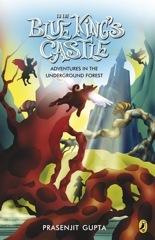
WHAT catches your attention first about Prasenjit Gupta's 'To The Blue King's Castle' is the fantastic cover design and illustration by Kunal Kundu. It promises a world of magic and adventure, replete with castles, flying creatures, strange plants, with the silhouette of a young girl in the foreground, your unmistakable protagonist. You know immediately that you are in for a ride through the realm of fantasy and the author certainly doesn't disappoint. Right from the first chapter, when Ritu, a young Indian-American, takes the escalator down to the lowest level of a mall and finds herself in the underground forest, we know the action has definitely begun.
We are immediately introduced to the next set of main characters: Serendipitious the resident magician and Blanc Noir, his loyal sidekick. Together, they journey to the Blue Castle to retrieve Dodgson's Box of Happiness to release the happy spirits back into the forest. Along the way, we meet an assorted set of characters and journey through interesting places like the Outcastes' Village, Mediapolis, the Bureaucrats' Maze (a bit too reminiscent, for me, of Asterix and his 12 Tasks), Strangers' Paradise, and more, each beguiling us with its innate familiarity turned upside down. Like most adventures, this does end happily, though Prasenjit has been careful to introduce some important themes, giving young readers ample food for thought. Deep questions like identity, the nature of truth, shifting perceptions, quality time with family, loyalty, are some of them.
If you are a language buff, then there is a lot of word play that Prasenjit indulges in - from character names (Precisian, Professor Cliché, Panini, Plum), to place names, to things (my favourite, the Emoto-mobile), to even the dialogue. Blanc Noir speaks only in rhyme, which gets tedious after the first few times, and there is the bad guy, Socrates, who recites meaningless poetry. Again, this version of nonsense verse seems out of place and hampers the flow of the story.
Prasenjit sticks to a linear narrative, but there are enough unpredictable twists and turns to keep the reader interested. However, one just feels there might be a bit too many, making this difficult to read at one go. And since we seem to be moving so quickly from one chapter to the next, some of the characters and plot points remain strictly two-dimensional.
Despite that, the book is entertaining, ending with a hint of a sequel, perhaps.
